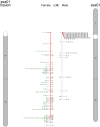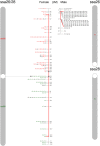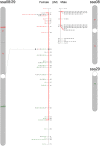Chromosomal differences between European and North American Atlantic salmon discovered by linkage mapping and supported by fluorescence in situ hybridization analysis
- PMID: 22928605
- PMCID: PMC3495403
- DOI: 10.1186/1471-2164-13-432
Chromosomal differences between European and North American Atlantic salmon discovered by linkage mapping and supported by fluorescence in situ hybridization analysis
Abstract
Background: Geographical isolation has generated a distinct difference between Atlantic salmon of European and North American Atlantic origin. The European Atlantic salmon generally has 29 pairs of chromosomes and 74 chromosome arms whereas it has been reported that the North American Atlantic salmon has 27 chromosome pairs and an NF of 72. In order to predict the major chromosomal rearrangements causing these differences, we constructed a dense linkage map for Atlantic salmon of North American origin and compared it with the well-developed map for European Atlantic salmon.
Results: The presented male and female genetic maps for the North American subspecies of Atlantic salmon, contains 3,662 SNPs located on 27 linkage groups. The total lengths of the female and male linkage maps were 2,153 cM and 968 cM respectively, with males characteristically showing recombination only at the telomeres. We compared these maps with recently published SNP maps from European Atlantic salmon, and predicted three chromosomal reorganization events that we then tested using fluorescence in situ hybridization (FISH) analysis. The proposed rearrangements, which define the differences in the karyotypes of the North American Atlantic salmon relative to the European Atlantic salmon, include the translocation of the p arm of ssa01 to ssa23 and polymorphic fusions: ssa26 with ssa28, and ssa08 with ssa29.
Conclusions: This study identified major chromosomal differences between European and North American Atlantic salmon. However, while gross structural differences were significant, the order of genetic markers at the fine-resolution scale was remarkably conserved. This is a good indication that information from the International Cooperation to Sequence the Atlantic salmon Genome, which is sequencing a European Atlantic salmon, can be transferred to Atlantic salmon from North America.
Figures







References
-
- Ohno S, Wolf U, Atkin NB. Evolution from fish to mammals by gene duplication. Hereditas. 1968;59(1):169–187. - PubMed
-
- Danzmann RG, Davidson EA, Ferguson MM, Gharbi K, Koop BF, Hoyheim B, Lien S, Lubieniecki KP, Moghadam HK, Park J. et al.Distribution of ancestral proto-Actinopterygian chromosome arms within the genomes of 4R-derivative salmonid fishes (Rainbow trout and Atlantic salmon) BMC Genomics. 2008;9:557. doi: 10.1186/1471-2164-9-557. - DOI - PMC - PubMed
-
- Allendorf FW, Thorgaard GH. Tetraploidy and the Evolution of Salmonid Fishes. Plenum Press, New York; 1984.
Publication types
MeSH terms
LinkOut - more resources
Full Text Sources

